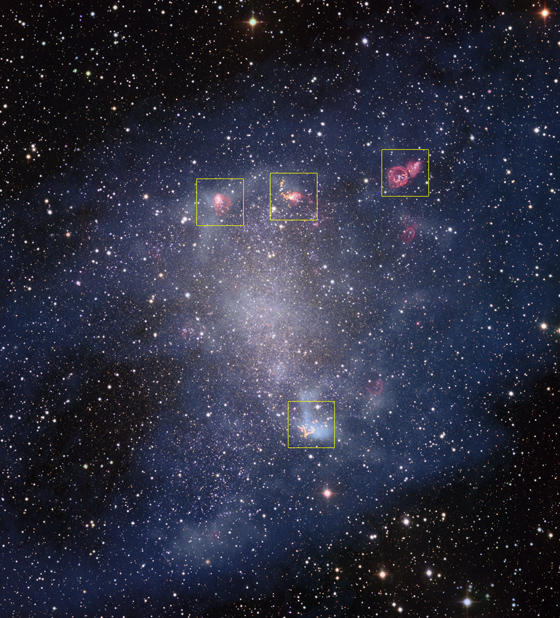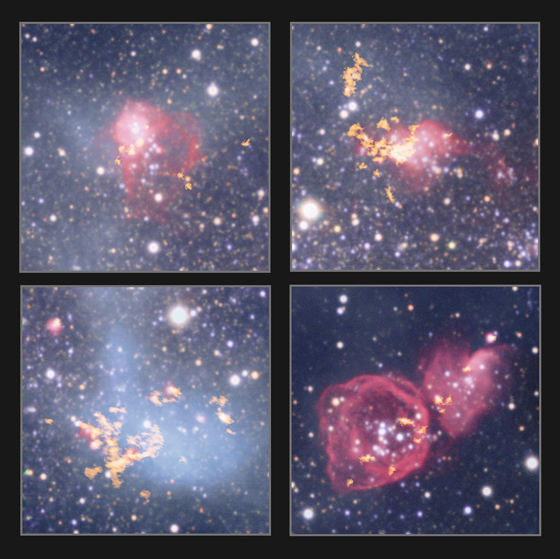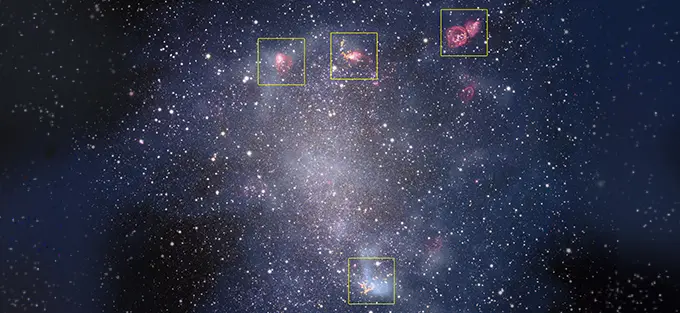ALMA peers into star-forming gas regions outside our Milky Way
An international team of astronomers has used the Atacama Large Millimeter/submillimeter Array (ALMA) to zoom into sites of star formation in the nearby galaxy NGC 6822. The new ALMA observations reveal the structure of star-forming gas clouds with a high level of detail making in possible to compare it to similar regions in our home galaxy. They indicate that the physics of star formation may be the same of small mass, pristine galaxies - the building blocks of more massive galaxies - as in our Galaxy.

Observations in the Milky Way have shown that stars form in the dense cores of giant gas clouds, where the gas can reach temperatures cold enough to become susceptible to gravitational collapse. The same conditions foster the formation of molecules which are indispensable observational tracers of gas in galaxies.
So far, observations were unable to resolve the sites of star formation outside the Milky Way. Not only are those galaxies much farther away and therefore appear smaller, but the galaxies closest to the Milky Way are also of low mass with slow stellar build-up and limited heavy elemental enrichment of their gas reservoir - rendering observations even harder. These pristine conditions result not only in a lack of molecules, but they may also lead to a hostile environment for the formation of cold gas, making star formation much harder.
ALMA has now overcome this observational limit by providing images two orders of magnitude sharper than commonly observed. The nearby low-mass galaxy NGC 6822 has been targeted, a small galaxy located 1.5 million light-years away with 500 times less mass than the Milky Way. The data reveal a plethora of small dense cores in the star-forming sites, with molecular tracers constrained to the densest cores. They fill a much lower volume than in Galactic star-forming clouds such as the Orion cloud.
"The difference in the appearance of star-forming gas clouds in NGC 6822 as compared to those in our Galaxy is striking,” remarks Andreas Schruba, who led the team at Max Plank Institute for Extraterrestrial Physics (MPE). “The observed molecules can only be found in tiny, dense cores, which explains why previous observations often remained unsuccessful."

The high spectral resolving power of ALMA lead to a second important discovery: Unexpectedly, despite the different distribution of the molecules, the dense gas cores show the same kinematics as similar-sized structures in our Galaxy. “From the width of the molecular lines we can infer the kinematic properties of the gas in these cores,” explains Andreas Schruba. “This finding is today's strongest observational evidence that the time evolution and the physics of star formation in these low-mass galaxies resemble those of the Milky Way.”
These observations, therefore, provide important clues to understanding star formation in low-mass galaxies, which are the building blocks of more massive galaxies such as the Milky Way. They can guide the interpretation of less-resolved observations of more distant galaxies.
Additional information
This text was adapted from ‘ ALMA peers into star-forming gas regions outside our Milky Way’ press release in MPE website.
This research was presented in a paper ‘Physical Properties of Molecular Clouds at 2 pc Resolution in the Low-metallicity Dwarf Galaxy NGC 6822 and the Milky Way'by Schruba et al. in The Astrophysical Journal.
The research team was composed by Andreas Schruba1, Adam K. Leroy2, J. M. Diederik Kruijssen3,4, Frank Bigiel5, Alberto D. Bolatto6, W. J. G. de Blok7,8,9, Linda Tacconi1, Ewine F. van Dishoeck1,10, and Fabian Walter4.
-
- 1 Max-Planck-Institut für extraterrestrische Physik, Giessenbachstraße 1, D-85748 Garching, Germany
-
- 2 Department of Astronomy, The Ohio State University, 140 W. 18th Street, Columbus, OH 43210, USA
-
- 3 Astronomisches Rechen-Institut, Zentrum für Astronomie der Universität Heidelberg, Mönchhofstraße 12-14, D-69120 Heidelberg, Germany
-
- 4 Max-Planck-Institut für Astronomie, Königstuhl 17, D-69117 Heidelberg, Germany
-
- 5 Institut für theoretische Astrophysik, Zentrum für Astronomie der Universität Heidelberg, Albert-Ueberle Str. 2, D-69120 Heidelberg, Germany
-
- 6 Department of Astronomy, Laboratory for Millimeter-Wave Astronomy, University of Maryland, College Park, MD 20742, USA
-
- 7 Netherlands Institute for Radio Astronomy (ASTRON), Postbus 2, 7990 AA Dwingeloo, The Netherlands
-
- 8 Astrophysics, Cosmology and Gravity Centre, Univ. of Cape Town, Private Bag X3, Rondebosch 7701, South Africa
-
- 9 Kapteyn Astronomical Institute, University of Groningen, P.O. Box 800, 9700 AV Groningen, The Netherlands
- 10 Leiden Observatory, Leiden University, P.O. Box 9513, 2300 RA, Leiden, The Netherlands
The Atacama Large Millimeter/submillimeter Array (ALMA), an international astronomy facility, is a partnership of the European Organisation for Astronomical Research in the Southern Hemisphere (ESO), the U.S. National Science Foundation (NSF) and the National Institutes of Natural Sciences (NINS) of Japan in cooperation with the Republic of Chile. ALMA is funded by ESO on behalf of its Member States, by NSF in cooperation with the National Research Council of Canada (NRC) and the Ministry of Science and Technology (MOST) in Taiwan and by NINS in cooperation with the Academia Sinica (AS) in Taiwan and the Korea Astronomy and Space Science Institute (KASI).
ALMA construction and operations are led by ESO on behalf of its Member States; by the National Radio Astronomy Observatory (NRAO), managed by Associated Universities, Inc. (AUI), on behalf of North America; and by the National Astronomical Observatory of Japan (NAOJ) on behalf of East Asia. The Joint ALMA Observatory (JAO) provides the unified leadership and management of the construction, commissioning and operation of ALMA.
Contacts
-
Nicolás Lira
Education and Public Outreach CoordinatorJoint ALMA Observatory, Santiago - ChilePhone: +56 2 2467 6519Cel: +56 9 9445 7726Email: [email protected] -
Richard Hook
Public Information Officer, ESOGarching bei München, GermanyPhone: +49 89 3200 6655Cel: +49 151 1537 3591Email: [email protected] -
Masaaki Hiramatsu
Education and Public Outreach Officer, NAOJ Chile -
Charles E. Blue
Public Information OfficerNational Radio Astronomy Observatory Charlottesville, Virginia - USAPhone: +1 434 296 0314Cel: +1 202 236 6324Email: [email protected]

